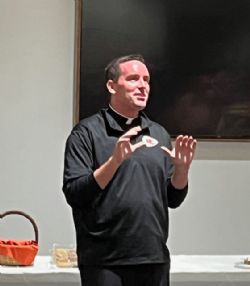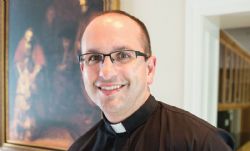
Promulgated by the United States Council of Catholic Bishops on the Solemnity of the Sacred Heart of Jesus, June 24, 2022, the new Program of Priestly Formation (PPF), 6th Edition, resulted in significant changes in the course of seminary studies for men discerning the Catholic priesthood. Seminarians of the Archdiocese of Kansas City in Kansas at both St. John Vianney Theological Seminary in Denver, CO, and Kenrick-Glennon Seminary in St. Louis, MO, began the new formation program upon return to their studies (or, in the case of new seminarians, the commencement of their studies) this fall.
Gone is the former terminology describing the stages of formation: “Pre-Theology I and II,” and “Theology I, II, III, and IV,” replaced by new terminology (and, in some cases, new experiences for the seminarian): the “Propaedeutic” (pronounced “pro-pa-DOO-tick”) stage, the “Discipleship” stage, the “Configuration” stage, and the “Vocational Synthesis” stage.
“Propaedeutic” formation for new seminarians is a one- to three-year period of initial formation meant to be something like a novitiate for diocesan priesthood wherein seminarians are set apart in a contemplative life of work and prayer. Some programs incorporate a “technology fast” and the experience has similarities to what previously was known as a “Spirituality Year,” though the Propaedeutic Stage can be longer than a calendar year. From the PPF: “The propaedeutic stage seeks to provide seminarians with the basic groundwork they need to engage in priestly formation. Through no fault of their own, the requisite qualities for formation are often missing in new seminarians. A significant imbalance is present between the lifestyle promoted by contemporary society and priestly formation. There are many generous young men open to a priestly call who nevertheless need more intensive preparation before they are ready to enter into the discipleship stage of formation; thus, a propaedeutic stage prior to the discipleship stage is essential.” (PPF 119)
“Discipleship,” is the heart of priestly discernment and the stage in which full-time study of Philosophy is undertaken. This stage must last not less than two (2) years and it has at its core the goal of growing in an intimate relationship with Jesus Christ. Men without a college degree work toward a B.A. in Philosophy. Men with college degrees at this stage work to fulfill the necessary Philosophy curriculum in preparation for the study of Theology in the next stage. Discipleship lasts between two and four years, and the Church envisions that the man and his (arch)diocese will be able to determine whether he is called to be a priest in service of his (arch)diocese by the end of this stage.
The third stage of formation, “Configuration,” typically lasts four (4) years. Having determined that a man is in fact called to priesthood for his (arch)diocese, the tenor of seminary formation switches from that of vocational discernment to priestly preparation. The emphasis of formation is one of being increasing configured to Jesus Christ who is Head, Shepherd, Servant, and Spouse to the Church. The seminarian continues to grow in his capacity to make a gift of himself to others after the pattern of Jesus and begins to hone the skills he will eventually use in ministry – such as preaching, celebration of the sacraments, and pastoral counseling. Configuration Stage seminarians also customarily wear the clerical collar and attire worn by priests.
After the completion of Configuration, the seminarian is ordained a transitional deacon. This then inaugurates the final stage of formation, Vocational Synthesis, which consists of a six-month period during which the newly ordained man lives and serves in a parish of his (arch)diocese prior to being ordained to the priesthood. This experience is similar to the current Pastoral Year, although the seminarian is now an ordained deacon as opposed to a second year theologian, and the length of time is six (6) months as opposed to a year. Like the Propaedeutic Stage, the Vocational Synthesis Stage is something new to the American experience of seminary formation. It is so new in fact that it likely won’t start to impact seminarians until several years from now, as the new program of formation matures. Vocational Synthesis ends with priestly ordination.
The central focus of this latest version (6th edition) of the Program of Priestly Formation comes from reflecting on the lived experience of seminaries and the Church in the United States in these opening decades of the twenty-first century and takes its inspiration from the Ratio Fundamentalis published in 2016: “The fundamental idea is that Seminaries should form missionary disciples who are ‘in love’ with the Master, shepherds ‘with the smell of the sheep,’ who live in their midst to bring the mercy of God to them.” (PPF 3)
The photo above is of seminarians, including ArchKCK seminarians, at Kenrick-Glennon Seminary in St. Louis, MO. The lead photo on the home page associated with "Feature Story" is of theologians receiving Candidacy, taken at St. John Vianney Seminary in the spring of 2023.




